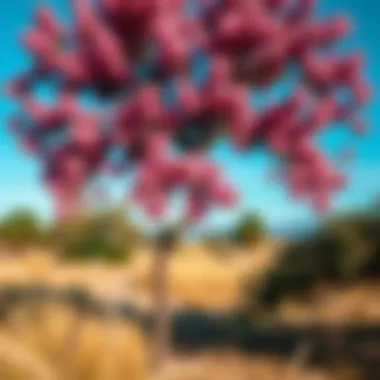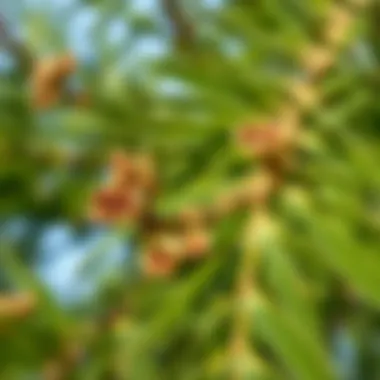Exploring the Desert Willow Tree in Texas


Intro
The desert willow tree, with its striking blossoms and ability to flourish in harsh environments, isn’t just eye-catching; it’s also a beacon of resilience in Texas's varied flora. Its adaptability means it can thrive in some of the most challenging conditions, making it a delight for both homeowners and nature enthusiasts alike. As more people recognize the importance of sustainable practices in landscaping, the desert willow stands out as a prime candidate for enhancing biodiversity and promoting ecological health.
In this article, we will explore the various aspects of the desert willow tree, from its botanical characteristics to its ecological importance. We’ll discuss techniques for cultivating this beautiful tree, how it fits into sustainable landscaping practices, and its broader implications for preserving regional flora.
Let’s roll up our sleeves and dig into the finer points of this remarkable tree and how it can serve both aesthetic and practical purposes in the great Texan landscape.
Overview of Forestry Practices
To truly appreciate the desert willow tree's place in the Texas ecosystem, it helps to understand the overarching practices that govern forestry in the region. Forestry practices are not merely about planting trees; they encompass a range of activities designed to maintain and enhance the health of forests and woodlands.
Importance of Foresting
Forests play a critical role in the environment. They are vital for:
- Biodiversity: Providing habitat for countless species.
- Climate Regulation: Acting as carbon sinks, they help curtail climate change.
- Water Cycle: Forests impact groundwater levels and influence rainfall patterns.
Therefore, responsible forest management practices ensure that forests can continue to thrive and benefit both ecosystems and human activities.
Types of Forestry Practices
Not all forestry is created equal. Here are some notable practices relevant to Texas:
- Selective Harvesting: This involves carefully choosing which trees to cut down and which to preserve. This method fosters a healthier forest structure.
- Reforestation Efforts: Planting new trees where old ones have been cut or have died helps restore balance.
- Agroforestry: Integrating trees into agricultural landscapes contributes to both productivity and ecological health, allowing trees like the desert willow to flourish alongside crops.
Best Practices for Sustainable Woodland Stewardship
Sustainable woodland stewardship focuses on practices that meet present needs without compromising the ability of future generations to meet theirs. Ensuring the long-term health of trees, including the desert willow, rests upon principles that guide responsible management.
Principles of Sustainable Forestry
Understanding the principles is key:
- Diversity: Planting diverse species creates resilience against pests and diseases.
- Ecosystem Health: Regular assessments of ecosystem conditions can help monitor changes.
- Community Involvement: Engaging local communities boosts support for sustainable practices and enhances local knowledge.
Techniques for Land Management
Adopting effective land management techniques can significantly enhance the sustainability of forested areas:
- Soil Erosion Control: Utilizing cover crops and maintaining ground cover can prevent soil erosion, which is crucial for sustaining the desert willow.
- Water Conservation: Implementing efficient irrigation systems ensures that trees receive adequate hydration without depleting local water resources.
- Invasive Species Control: Actively managing and removing non-native species fosters a healthier native ecosystem.
Innovative Techniques in Forestry
As the field of forestry evolves, new techniques and technologies are emerging, paving the way for more effective management methods.
Latest Technological Advancements
From satellite imagery to AI-driven analytics, technology has revolutionized how forests are monitored and managed. These advancements help track tree health, growth patterns, and the ecosystem's response to changes in climate or land use.
Integrating Traditional Knowledge with Modern Science


The melding of traditional ecological knowledge with modern practices gives a rounded approach to forestry. Local communities have often cultivated trees like the desert willow for generations. Their insights can guide contemporary methods, ensuring practices are not only effective but also culturally respectful.
"Incorporating traditional ways with today’s techniques is like mixing old wine into new bottles; it heightens the flavor of sustainable practices."
Through this exploration of the desert willow and its context within forestry, we can foster not just appreciation, but also active participation in preserving this beautiful aspect of Texas’s natural landscape.
Prologue to the Desert Willow Tree
The desert willow tree, known for both its beauty and resilience, occupies a fascinating place in the botanical landscape of Texas. Recognizing the significance of this unique species serves not only to enhance one’s appreciation of local flora but also highlights practical applications in improving environmental sustainability. The Chilopsis linearis is a marvel of adaptation, thriving in arid conditions where most plants would struggle. By delving into the characteristics, history, and cultivation of the desert willow, one gains insight into its multifaceted contributions to both local ecosystems and human endeavors.
Definition and Botanical Characteristics
The desert willow is not a true willow but rather belongs to the Bignoniaceae family. It typically grows anywhere between 15 to 25 feet tall, showcasing an open canopy that provides partial shade. Its leaves are long and slender, resembling those of the true willow, but they flourish in a vibrant green color that shimmers under the Texas sun.
Notably, the tree blooms in the summer, producing delightful trumpet-shaped flowers in varying shades of white, pink, and purple. These blossoms are not merely ornamental; they play a role in attracting pollinators like bees and hummingbirds, effectively enhancing local biodiversity. The adaptability of the desert willow enables it to flourish in poor or sandy soils and withstand periods of drought. Moreover, its remarkable resistance to pests and diseases highlights its suitability for both residential and commercial landscapes.
History and Origin
The history of the desert willow traces back to regions of the southwestern United States, including Texas, where it has rooted itself in the local culture and environment. Indigenous communities utilized the tree for various purposes, including crafting tools and weaving materials from its pliable branches. Its aesthetic qualities caught the eye of settlers who later recognized its utility in ornamental landscaping and erosion control.
Through the years, the desert willow has become a symbol of resilience amid harsh conditions, embodying the spirit of the region. As environmental concerns rise, the role of the desert willow in restoration projects and as a solution for sustainable landscaping has garnered increased interest, making it a valuable specimen in ongoing ecological discussions.
Ecological Significance of the Desert Willow
The Desert Willow, or Chilopsis linearis, is not just a pretty face in the arid landscapes of Texas; it plays a crucial role in the environment. This tree is well adapted to survive in harsh climates, making it an essential component for numerous ecosystems across the region. Let’s delve deeper into its habitat, native range, and its pivotal role in local ecosystems.
Habitat and Native Range
The Desert Willow is native to the southwestern United States, stretching from Texas into parts of Arizona and New Mexico, and down into Mexico. You’ll typically find it growing in riparian zones, areas near rivers, and low-lying valleys. This tree thrives in hard, dry terrains, where other vegetation might struggle. Its existence here is a testament to nature's resilience, where it can endure drought and heat like a champ.
- Soil Adaptability: It’s known for its tolerance to diverse soil types, thriving even in sandy or gravelly substrates.
- Sunlight Needs: Full sun is its strong suit. It flourishes best when it receives plenty of direct sunlight, making it ideal for open spaces in landscapes.
- Water Requirements: While generally drought-resistant, it does benefit appreciably from irrigation during dry spells, particularly in young stages.
This ability to adapt helps the Desert Willow not only survive but thrive in environments that are unforgiving to many other plant species. The presence of these trees often indicates healthy, flowing water systems, which is vital in maintaining ecosystem balance.
Role in Local Ecosystems
In their native habitats, Desert Willows act as a cornerstone species. They provide numerous ecological functions:
- Wildlife Habitat: These trees serve as a sanctuary for various birds and small mammals. The long, showy flowers attract pollinators like bees and hummingbirds. They are particularly fond of the sweet nectar produced, which means they come buzzing around in droves during blooming season.
- Erosion Control: The robust root systems stabilize the soil, preventing erosion along riverbanks which, in turn, safeguards water quality in adjacent water bodies.
- Shade and Cooling: As an offering of shade, Desert Willows can moderate the temperature of their surrounding environment, which is vital for smaller plants and animals looking for respite from the blistering sun.
- Nutrient Cycling: Their leaf litter returns valuable nutrients back into the soil, enriching it over time and helping maintain a diverse plant community.
"The Desert Willow illustrates nature’s intricate web, highlighting how interconnected our ecosystems are and the importance of maintaining each species within it."
By fostering biodiversity and supporting local wildlife, the Desert Willow is not merely a tree; it is a keystone species that enhances ecological stability. Understanding its ecological significance can steer conservation efforts and promote sustainable practices, ensuring that this beautiful tree continues to grace the Texas landscape for generations to come.
Cultivation of the Desert Willow Tree
The cultivation of the desert willow tree is pivotal to fully appreciate its various offerings, especially in regions like Texas. This tree isn't just a pretty face; it's an ecological powerhouse, and its ability to thrive in dry climates turns it into a prized asset for gardeners, landscapers, and environmentalists alike. Understanding the cultivation aspects paves the way for anyone looking to incorporate this native plant into their landscape or preservation efforts. It’s about knowing what conditions it needs to flourish, how to propagate it efficiently, and ensuring it gets the care it requires to thrive.
Preferred Growing Conditions
Desert willows find their sweet spot in habitats that mirror their natural environment, characterized by sunny and airy spaces. They prefer well-drained soil, which is often sandy or rocky, mimicking their native Southwestern habitats. Unlike many trees that droop in heavier, wet soils, the desert willow stands proud and tall when given the right conditions.


A sprinkle of drought tolerance is in their DNA; the desert willow can endure long dry spells, thanks to its deep taproot. Maintaining a sunny spot with at least six hours of full sunlight daily is also crucial for strong growth and abundant flowering.
Propagation Techniques
When it comes to propagation, desert willows don’t hold back. These trees can be started from seed, cuttings, or by grafting. Each method offers its own set of advantages and relies heavily on the gardener's preference and experience.
- Seeds: The seeds requires a bit of extra love before planting. Scarification helps germination. Soaking them in water for a day or two before sowing can make a world of difference. This method is ideal for larger-scale plantings.
- Cuttings: Taking semi-hardwood cuttings during the summer is another effective way. Just cut healthy branches, allow them to callus, and then plant in well-drained media. With the right conditions, you might see roots sprouting within weeks!
- Grafting: For those aiming to develop specific characteristics in growth, grafting techniques can be utilized, though it requires more skill.
Maintenance and Care Practices
Watering Guidelines
When discussing watering guidelines for the desert willow, it is a balancing act. While they possess an uncanny ability to endure drought, establishing young trees requires diligent watering. Make sure to keep the soil consistently moist through the first growing season. However, overwatering can lead to root rot, which is something no one wants.
- Key Characteristic: The primary focus during early growth is on deep soaking, encouraging roots to stretch down into the soil.
- Unique Feature: Their low water usage once established makes them a go-to option for xeriscaping, benefiting both water conservation efforts and the tree's long-term health. Proper watering practices can significantly reduce dependency on additional irrigation later.
Pruning Techniques
Pruning desert willows is not just an aesthetic pursuit; it plays a crucial role in their health. The tree develops a natural shape, but periodic pruning helps maintain it. Aim for late winter or early spring before the growing season kicks in.
- Key Characteristic: Removing dead or damaged wood encourages robust growth, and regular snipping can help control their size, which is particularly beneficial in limited garden spaces.
- Unique Feature: Pruning also stimulates flowering by allowing sunlight to penetrate better into the tree's canopy, leading to a show of blooms when the hot months roll around.
Pest and Disease Management
While desert willows are generally resilient, they are not invincible. Keeping an eye on common pests such as aphids or spider mites can save a lot of grief down the line.
- Key Characteristic: Integrated Pest Management (IPM) strategies emphasize monitoring rather than reacting. Handpicking pests or using insecticidal soap when populations are small can often do the trick without heavy reliance on harsh chemicals.
- Unique Feature: Keeping this natural pest management approach can strengthen the tree’s resilience. It minimizes toxins in the environment and supports beneficial insects that also play a role in a healthy local ecosystem.
Aesthetic Uses of the Desert Willow Tree
The desert willow tree is not just a pretty face in Texas landscapes; it holds significant aesthetic value that can elevate both residential and commercial spaces. Its unique beauty, coupled with practical advantages, makes it a popular choice for landscapers and urban planners alike. Not only does it thrive in arid environments, but it also adds an artistic touch that echoes the local flora.
Landscaping Applications
When it comes to landscaping, the desert willow tree brings with it a flair that is hard to beat. Its willow-like leaves sway gracefully and provide a feathery appearance, which softens harsh landscapes often found in dry regions. During blooming season, the tree bursts forth with lavender to white trumpet-shaped flowers, attracting pollinators like bees and hummingbirds, which adds a dynamic element to any garden.
The versatility of the tree makes it suitable for various landscaping styles, from xeriscaping to traditional gardens. Here are some specific applications:
- Accent Tree: The desert willow can stand alone or be used in clusters for visual impact. Its height and form create a wonderful focal point in any garden.
- Screening Benefit: Planting several desert willows can provide privacy from neighbors, acting as a natural screen while keeping the area aesthetically pleasing.
- Mixed Planting: Pair it with drought-tolerant succulents or shorter shrubs to create a visually appealing and varied landscape.
Role in Urban Planning
Urban planning has begun to embrace the desert willow tree due to its low maintenance and adaptability to urban stressors such as pollution and limited water. Cities aiming to enhance green spaces can significantly benefit by incorporating these trees. They contribute to urban biodiversity, providing habitats for various species while also improving air quality.
Here’s what to consider when integrating the desert willow into urban designs:
- Shade Provision: As urban areas become hotter, desert willows can offer essential shade, lowering the surrounding air temperature, which benefits both people and wildlife.
- Aesthetic Appeal: Their stunning blooms can beautify gray cityscapes, making them more inviting. This has been proven to enhance property values, which bodes well for real estate.
- Low Water Use: With the ongoing concerns of water conservation, desert willows require minimal irrigation once established, making them a financially sound choice for city budgets.
"Integrating native species like the desert willow not only beautifies urban settings but also respects local ecosystems."
The aesthetic uses of the desert willow tree in Texas are manifold. Its blend of beauty, functionality, and ecological significance is a testament to why it is celebrated in landscaping and urban planning. Whether creating a home garden or designing a public park, the desert willow proves it can meet the demands of aesthetic and environmental needs alike.


Benefits of the Desert Willow Tree
The desert willow tree embodies more than just a visual highlight in arid landscapes. Understanding its benefits is crucial for both ecological health and economic development, especially in regions like Texas where resilience against harsh conditions is paramount. This section delves into two primary benefits of the desert willow: its environmental advantages and economic contributions.
Environmental Advantages
The desert willow tree plays a notable role in maintaining the ecological balance in its native habitat. Here’s how:
- Water Conservation: This tree is remarkably drought-resistant, which makes it a smart choice for water-sensitive landscaping in Texas. The root system digs deep into the ground, tapping into underground moisture and thereby minimizing water usage.
- Soil Erosion Control: The desert willow’s extensive root network helps to stabilize the soil, preventing erosion in sandy terrains. This stability is especially vital in Texas, where high winds and rain can lead to significant soil loss.
- Habitat for Wildlife: The tree isn’t just a pretty face; it also provides shelter and food for various birds and insects. The fragrant blossoms attract bees, butterflies, and hummingbirds, enhancing local biodiversity and reinforcing important ecological networks.
"The desert willow acts as a keystone species in its environment, supporting both flora and fauna in arid regions."
- Air Quality Improvement: Like many trees, the desert willow contributes to cleaner air by absorbing carbon dioxide and releasing oxygen. This effect may be modest, but in urban areas, every bit counts in combating pollution.
Economic Contributions
Beyond its environmental impact, the desert willow tree offers valuable economic benefits that can’t be overlooked:
- Tourism and Aesthetics: The unique beauty of the desert willow makes it a sought-after feature in parks and gardens. Landscaping with this tree can enhance property values and draw in tourists keen on experiencing local flora, which can boost local economies.
- Landscaping Savings: Utilizing drought-resistant plants like the desert willow can reduce long-term landscaping costs. These trees require less water and maintenance, making them an attractive option for municipalities and homeowners looking to save on water bills and upkeep expenses.
- Sustainable Timber Production: Though not typically harvested for lumber, the desert willow still has potential for small-scale sustainable timber projects. Its wood is light and workable, making it suitable for crafting furniture or artisan items, which can add to the region's economic tapestry.
In summary, the desert willow tree is a multi-faceted gem within the Texan landscape. Its environmental and economic benefits present compelling reasons for both forestry professionals and residents to appreciate, cultivate, and promote this remarkable tree.
Challenges in Cultivating Desert Willows
Cultivating the desert willow tree is not without its share of challenges. Understanding these obstacles is paramount for anyone looking to integrate this beautiful plant into their landscape. While the desert willow is inherently adaptable, several factors can hinder its growth and overall health. Addressing these challenges not only promotes successful cultivation but also reinforces the tree’s role in enhancing biodiversity and ecological sustainability.
Common Diseases and Pests
The desert willow, Chilopsis linearis, while known for its resilience, is susceptible to certain diseases and pests that can threaten its vitality. Some of the more common afflictions include:
- Bacterial Leaf Spot: This disease, characterized by dark, water-soaked lesions, can defoliate a tree if not managed promptly. Implementing proper spacing during planting can enhance air circulation and reduce the likelihood of outbreaks.
- Powdery Mildew: Conditions of high humidity can contribute to the growth of this fungal disease. It often manifests as white, powdery spots on leaves. To mitigate this, it's advisable to avoid overwatering and ensure that the foliage dries before nightfall.
- Pests: Among the most notable pests affecting desert willows are the Cottonwood Borer and the Willow Leaf Beetle. They can cause considerable damage if populations explode. Consider introducing beneficial insects, such as ladybugs, which can help manage these pests biologically.
With any of these issues, prompt identification and treatment are crucial. Routine inspections of your trees can aid in catching problems early, ensuring the longevity and health of the plant.
Environmental Stress Factors
Desert willows thrive in arid environments, but they aren't invincible. Various environmental stress factors can impact growth, making it crucial for cultivators to be well-informed. Key environmental stressors include:
- Drought: Given the desert willow's origins, it's surprisingly sensitive to prolonged drought periods. Although established trees are somewhat drought tolerant, young saplings especially should have consistent moisture during their early years.
- Soil Quality: These trees prefer well-drained, sandy or loamy soils. Heavy, compact clay can waterlog the roots, leading to rot. Those looking to cultivate must be mindful of their soil conditions, and if necessary, incorporate mulch to facilitate adequate drainage.
- Temperature Fluctuations: Extreme temperatures—both high and low—can stress plants. Significant drops in temperature can injure young trees, while scorching heat may lead to sunburn on exposed trunk and branches. It’s advisable to place young trees in locations where they’re shielded from harsh afternoon sun to maximize their chances of survival.
A well-thought-out strategy addressing these challenges can lead not just to healthier trees but also to a flourishing landscape that underscores the desert willow's environmental significance.
Future Perspectives on Desert Willow Trees
The future of the desert willow tree holds significant implications not just for its ecological role but also for the broader context of environmental sustainability. As urban spaces expand and climate change continues to pose challenges, the adaptability of the desert willow makes it a critical species to consider. By understanding its future perspectives, stakeholders can make informed decisions that not only enhance biodiversity but also improve urban environments in Texas and beyond.
Research and Conservation
Ongoing research into the desert willow tree is essential for its long-term conservation. Scientists are investigating various aspects of the tree's biology, including genetic diversity and its ability to withstand extreme weather conditions. Understanding these factors is paramount, especially as climate change leads to unpredictable weather patterns.
- Genetic Studies: By identifying genetic variations within populations of desert willows, researchers can determine which strains are most resilient. This knowledge can be applied in conservation strategies and restoration projects, ensuring that the right genetic resources are utilized for reforestation efforts.
- Habitat Restoration: Projects focused on restoring native habitats often incorporate desert willows because they support local fauna by providing shelter and food. Research into optimal planting techniques and conditions can enhance these efforts, making them more effective.
- Impact Assessments: There is a need for thorough studies assessing how the introduction of desert willows into urban and suburban landscapes influences local ecosystems. Such research will help gauge the tree's potential to mitigate urban heat and improve air quality, thereby contributing to sustainability goals in urban planning.
"Integrating native species like the desert willow into urban landscapes can lead to a more resilient urban ecosystem, benefiting both wildlife and human populations."
Public Awareness and Education
Raising public awareness about the desert willow's benefits and characteristics contributes to its appreciation as a native species. Awareness campaigns can foster a culture of respect for local flora, encouraging communities to incorporate desert willows into their landscapes. Education initiatives can take many forms:
- Workshops and Community Events: Organizing events focused on gardening with native plants can demystify the desert willow and showcase its aesthetic and ecological value. For example, hands-on workshops can teach residents how to properly plant and care for these trees in their own backyards.
- Educational Materials: Providing easily accessible information through brochures, websites, and social media platforms can simplify knowledge sharing. This information should emphasize how desert willows thrive in arid conditions, their role in supporting local wildlife, and their minimal care requirements.
- Collaborations with Schools: School programs could include the desert willow in their curriculum, helping students learn about local ecology. Creating school gardens featuring these trees fosters a direct connection between students and their environment.















